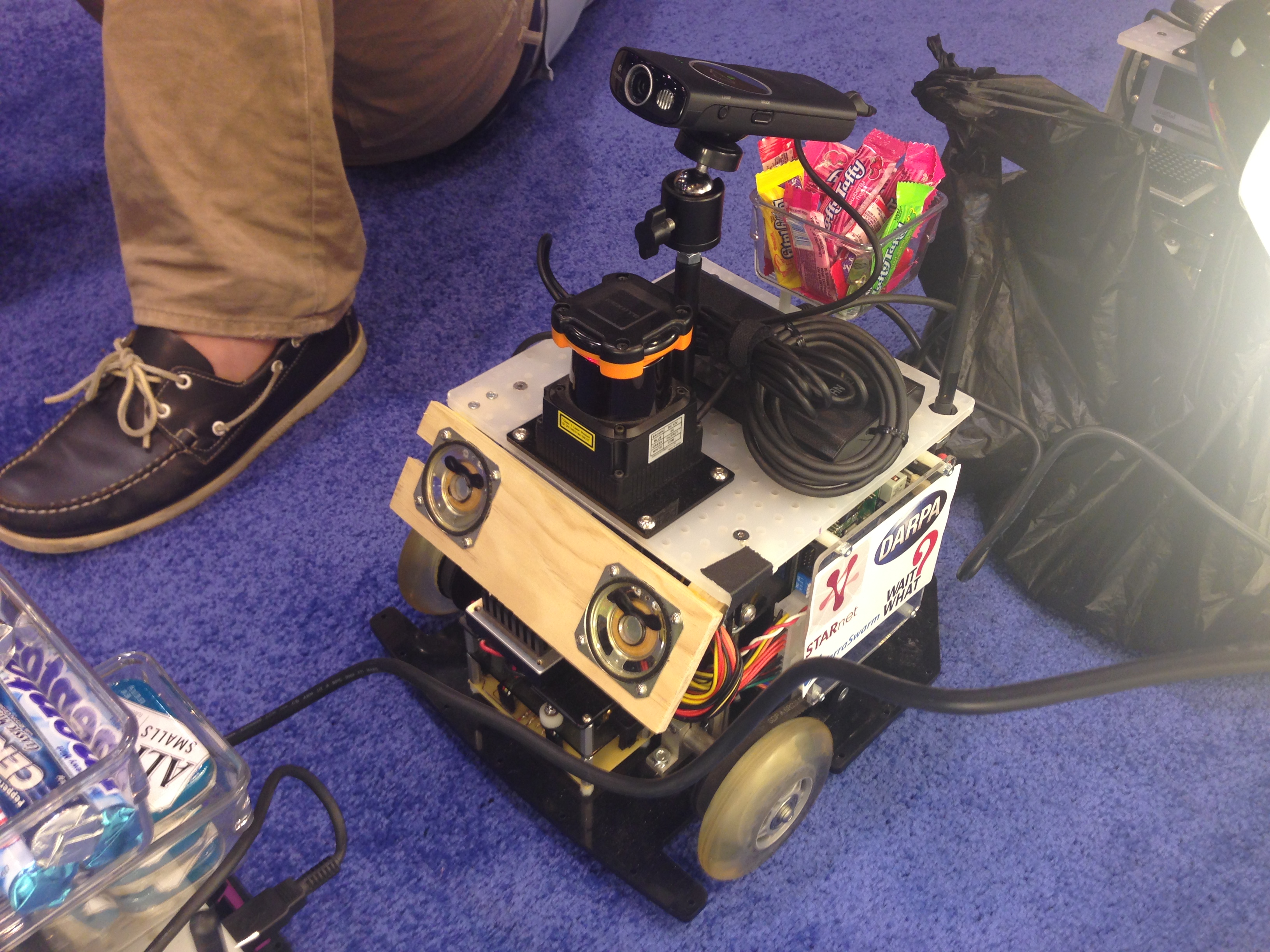TerraSwarm participated in the
DARPA Wait, What? technology forum held in St. Louis, September 9-11, 2015.
The Wait, What? Demo illustrated TerraSwarm
infrastructure innovations on robot swarms and connected sensors. The
demonstration included cooperating robots solving more than one problem,
and on-the-fly re-tasking to move from one problem to the next.
At the DARPA Wait What? conference, the TerraSwarm team from
five universities integrated five exciting and best-in-class
technologies to showcase the types of applications enabled by the
TerraSwarm research center. The demo focused on a robot delivery service
where a team of
Scarab robots (designed, built, and programmed at the
University of Pennsylvania) delivered snacks to onlookers at the touch
of a button. The user interface for the demo was a smartphone app,
running on unmodified smartphones. After making a selection, the system
dispatched a robot carrying the snack directly to the attendee, even as
the attendee walked around. While the robot's main goal was the delivery
application, to demonstrate how the robots could be repurposed in
real-time, a context-aware machine learning application ran in the
background that could interrupt the robots in response to an event.
Finally, one of the robots simultaneously performed a surveillance task
by carrying a video camera. The video stream was fed to a video
summarizer which extracted the most interesting and novel clips from the
stream in real-time. Instead of watching an hour long video, examining
what the robot had seen was compressed to a minute long summary of
several interesting clips.
This composition of
various technologies highlights what can be done when independent
systems work together. Applications in smart manufacturing, warehouse
management, in-the-field delivery, disaster relief, and monitoring and
security can all benefit from these services interoperating.
The
demo centered around our smartphone app which both presented to
visitors the snack options the robots could deliver, and also ran an
indoor localization service known as
ALPS (developed by a team at
Carnegie Mellon University) in the background. ALPS uses fixed anchor
nodes (which were positioned around the demo space) which periodically
transmit ultrasonic chirps to localize off-the-shelf smartphones. While
the chirps are at a frequency above the human hearing range, they are
still audible to the microphone circuitry in phones, and based on when
the phone receives the chirp and the speed of sound, the ALPS system can
calculate the location of the phone.
 |
| Figure 1. Students using the app to request a delivery. |
The
attendee's snack request and current location are fed to the application
coordinator which is an
Accessors based application running on the
Ptolemy software platform (both developed by a team at UC Berkeley).
Ptolemy is a visual, actor-oriented programming environment where
applications are composed by connecting the inputs and outputs of the
system blocks together. Accessors enable those blocks to represent
external, real-world devices, such as the robots or the phones running
ALPS. Ptolemy provides a central point to both describe and implement
the application, as well as manage the data flowing through the system.
 |
| Figure 2. Scarab
Robot with camera used for video summarization and
candy. (source: Ilge Akkaya) |
The
robots operate semi-autonomously, and use the ALPS position updates as
waypoints to complete their deliveries. With a known map of the space,
the robots receive their next waypoint, calculate a path to that goal,
and navigate that path independently. If any obstacles present
themselves, including other robots, people walking around, or changes in
the environment, the robots both detect the change and navigate around
the obstruction.
 |
| Figure 3. The map showing the direction of robots. (source: Ilge Akkaya) |
 |
Figure 4. Scarab robots in motion, making deliveries. (source: Ilge Akkaya) |
While the robots are making
deliveries, a microphone is passively listening in the background and
running a machine learning model trained to detect applause (as setup by
the UC Berkeley team). The relevant features of the audio stream are
extracted locally, and then processed by the
GMTK machine learning
toolkit (developed at the University of Washington) to determine if
there was applause in the space. When applause is detected, the robots
are interrupted from their deliveries, spin in place, and then continue
serving snacks. This reconfiguration is a placeholder for a more serious
event, such as the robots being able to re-task themselves to respond
when a disaster is detected.
The robot that is
filming its environment is streaming the video feed to a video
summarization tool (developed by a team at the University of
Washington). The video summarizer is, in real-time, analyzing the stream
for interesting and novel clips that best describe the video as a
whole. It aggregates these clips as a summary of the video. Essentially,
the information inside the video is preserved, but the length is
significantly reduced, making an originally intractable
problem---monitoring the video feeds from a swarm of robots---feasible.
These
systems are the cutting-edge technologies and research occurring inside
the TerraSwarm research center. To demonstrate how they can be used
connected to create otherwise impossible applications, the team at the
University of Michigan focused on the systems engineering aspect:
architecting the application, bringing together the components, defining
interfaces between them, and ensuring the demo worked as expected. By
successfully incorporating state-of-the-art research projects from
multiple universities, the Wait What? demo showcased the true potential
of multi-institution research collaborations like TerraSwarm.
(Source of text: Brad Campbell)




